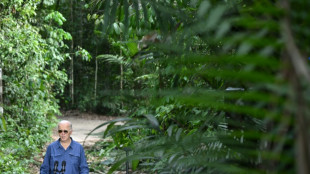
-
 Biden answers missile pleas from Ukraine as clock ticks down
Biden answers missile pleas from Ukraine as clock ticks down
-
Senegal ruling party claims 'large victory' in elections

-
 Dutch plan 'nice adios' for Nadal at Davis Cup retirement party
Dutch plan 'nice adios' for Nadal at Davis Cup retirement party
-
Trump meets PGA boss and Saudi PIF head amid deal talks: report

-
 UN chief urges G20 'leadership' on stalled climate talks
UN chief urges G20 'leadership' on stalled climate talks
-
Steelers edge Ravens, Lions maul Jaguars

-
 No.1 Korda wins LPGA Annika for seventh title of the season
No.1 Korda wins LPGA Annika for seventh title of the season
-
Biden touts climate legacy in landmark Amazon visit

-
 England secure Nations League promotion, France beat Italy
England secure Nations League promotion, France beat Italy
-
Star power fails to perk up France's premiere wine auction

-
 Rabiot brace fires France past Italy and top of Nations League group
Rabiot brace fires France past Italy and top of Nations League group
-
Carsley relieved to sign off with Nations League promotion for England

-
 Sinner says room to improve in 2025 after home ATP Finals triumph
Sinner says room to improve in 2025 after home ATP Finals triumph
-
Senegal counts votes as new leaders eye parliamentary win

-
 Biden clears Ukraine for long-range missile strikes inside Russia
Biden clears Ukraine for long-range missile strikes inside Russia
-
Lebanon says second Israeli strike on central Beirut kills two

-
 Puerto Rico's Campos wins first PGA title at Bermuda
Puerto Rico's Campos wins first PGA title at Bermuda
-
Harwood-Bellis risks wedding wrath from Keane after England goal

-
 'Nobody can reverse' US progress on clean energy: Biden
'Nobody can reverse' US progress on clean energy: Biden
-
NBA issues fines to Hornets guard Ball, T-Wolves guard Anthony

-
 Biden allows Ukraine to strike Russia with long-range missiles: US official
Biden allows Ukraine to strike Russia with long-range missiles: US official
-
Britain dump out holders Canada to reach BJK Cup semi-finals

-
 Biden clears Ukraine for missile strikes inside Russia
Biden clears Ukraine for missile strikes inside Russia
-
Ukrainians brave arduous journeys to Russian-occupied homeland

-
 Australia not focusing on Grand Slam sweep after thrashing Wales
Australia not focusing on Grand Slam sweep after thrashing Wales
-
Wales's rugby woes -- three talking points

-
 Jannik Sinner, the atypical Italian star on top of the tennis world
Jannik Sinner, the atypical Italian star on top of the tennis world
-
'Devil is in the details,' EU chief says of S.America trade deal

-
 Kusal Mendis defies injury as Sri Lanka beat New Zealand to clinch ODI series
Kusal Mendis defies injury as Sri Lanka beat New Zealand to clinch ODI series
-
Gatland would back change after Australia condemn Wales to record defeat

-
 England rout Ireland to earn Nations League promotion in Carsley farewell
England rout Ireland to earn Nations League promotion in Carsley farewell
-
England secure Nations League promotion, Haaland inspires Norway

-
 Sinner sweeps past Fritz to win ATP Finals
Sinner sweeps past Fritz to win ATP Finals
-
Massive Russian air attack pounds Ukraine as 1,000th day of war nears

-
 Mahrez scores as five-goal Algeria crush Liberia
Mahrez scores as five-goal Algeria crush Liberia
-
Toll in Tanzania building collapse rises to 13, survivors trapped

-
 'Red One' tops N.America box office but could end up in the red
'Red One' tops N.America box office but could end up in the red
-
NATO's largest artillery exercise underway in Finland

-
 Australia condemn Wales to record 11th successive loss in 52-20 rout
Australia condemn Wales to record 11th successive loss in 52-20 rout
-
Russian opposition marches against Putin in Berlin

-
 Ukraine announces power restrictions after 'massive' Russian attack
Ukraine announces power restrictions after 'massive' Russian attack
-
Biden begins historic Amazon trip amid Trump climate fears

-
 Dozens killed, missing in Israeli strike on devastated north Gaza
Dozens killed, missing in Israeli strike on devastated north Gaza
-
Macron defends French farmers in talks with Argentina's Milei

-
 England players to blame for losing streak says captain George
England players to blame for losing streak says captain George
-
'Emotional' Martin defies Bagnaia to claim first MotoGP world championship

-
 Slovakia beat Australia to reach BJK Cup semi-finals
Slovakia beat Australia to reach BJK Cup semi-finals
-
Sluggish Italy fight to narrow win over Georgia

-
 India and Nigeria renew ties as Modi visits
India and Nigeria renew ties as Modi visits
-
Grit and talent, a promise and a dilemma: three things about Jorge Martin


Earthquakes, not just volcanic ash, a Pompeii killer: research
Victims who perished in Pompeii after the devastating 79 AD eruption of Mount Vesuvius may have been killed by a simultaneous earthquake, according to new research published on Thursday.
Scholars have debated for decades whether seismic activity occurred during the eruption of Vesuvius in southern Italy nearly 2,000 years ago, and not just before it, as reported by Pliny the Younger, an author and administrator in Ancient Rome, in his letters.
The article published on Thursday in the academic journal "Frontiers in Earth Science" takes a new look at the now world-famous archaeological site, arguing that one or more concurrent earthquakes were "a contributing cause of building collapse and death of the inhabitants".
"Our conclusions suggest that the effects of the collapse of buildings triggered by syn-eruptive seismicity (seismic activity at the time of an eruption) should be regarded as an additional cause of death in the ancient Pompeii," it said.
Archaeologists estimate that 15 to 20 percent of Pompeii's population died in the eruption, mostly from thermal shock as a giant cloud of gases and ash covered the city.
Volcanic ash then buried the Roman city, perfectly preserving the homes, public buildings, objects and even the people until its discovery in the late 16th century.
In May 2023, archaeologists uncovered the skeletons of two men who appeared to have been killed not by heat and clouds of fiery gas and ash but from trauma due to collapsed walls -- providing precious new data.
One of the victims was discovered with his left hand raised, as if to protect his head.
"It is worth noting that such traumas are analogous to those of individuals involved in modern earthquakes," wrote the authors, who determined that the collapsed walls were not due to falling stones and debris but to seismic activity.
"In a broader view that takes into account the whole city, we consider, as a working hypothesis, that the casualties caused by seismically triggered building failures may not be limited to the two individuals," the authors wrote.
The intersection of phenomena from both volcanic and seismic activity requires a multidisciplinary approach, the study argues, with the collaboration of both archaeologists and earth scientists.
R.Chavez--AT




